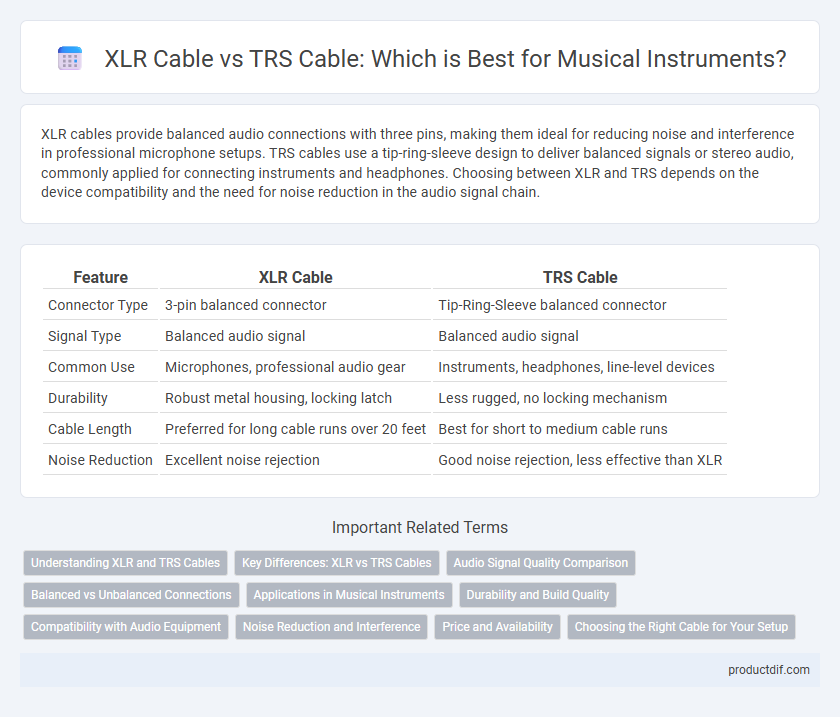XLR cables provide balanced audio connections with three pins, making them ideal for reducing noise and interference in professional microphone setups. TRS cables use a tip-ring-sleeve design to deliver balanced signals or stereo audio, commonly applied for connecting instruments and headphones. Choosing between XLR and TRS depends on the device compatibility and the need for noise reduction in the audio signal chain.
Table of Comparison
| Feature | XLR Cable | TRS Cable |
|---|---|---|
| Connector Type | 3-pin balanced connector | Tip-Ring-Sleeve balanced connector |
| Signal Type | Balanced audio signal | Balanced audio signal |
| Common Use | Microphones, professional audio gear | Instruments, headphones, line-level devices |
| Durability | Robust metal housing, locking latch | Less rugged, no locking mechanism |
| Cable Length | Preferred for long cable runs over 20 feet | Best for short to medium cable runs |
| Noise Reduction | Excellent noise rejection | Good noise rejection, less effective than XLR |
Understanding XLR and TRS Cables
XLR cables feature three pins and are primarily designed for balanced audio signals, providing superior noise rejection and reliable microphone connections in professional recording and live sound environments. TRS cables, with tip-ring-sleeve connectors, also support balanced signals but are commonly used for instruments, headphone outputs, and line-level connections. Understanding the structural differences and typical applications helps musicians and audio engineers choose the right cable for signal integrity and equipment compatibility.
Key Differences: XLR vs TRS Cables
XLR cables feature three-pin connectors designed primarily for balanced audio signals, offering superior noise rejection in professional music setups. TRS cables, with tip-ring-sleeve connectors, carry both balanced audio and stereo unbalanced signals, commonly used for headphones or line-level instruments. While XLR cables excel in microphones and long cable runs, TRS cables are favored for shorter distances and connecting keyboards or audio interfaces.
Audio Signal Quality Comparison
XLR cables provide balanced audio transmission, reducing electromagnetic interference and hum, which ensures clearer sound quality for professional musical instruments and recording setups. TRS cables also offer balanced connections but are more prone to signal degradation over longer distances compared to XLR cables. Musicians and audio engineers often prefer XLR cables for maintaining optimal audio fidelity in live performances and studio environments.
Balanced vs Unbalanced Connections
XLR cables provide balanced connections that effectively reduce noise and interference, making them ideal for professional audio equipment and live performances. TRS cables can also offer balanced connections but are commonly used for shorter cable runs and consumer audio devices. Unbalanced cables, typically associated with TS connectors, are more susceptible to noise, limiting their use in high-interference environments.
Applications in Musical Instruments
XLR cables are preferred for connecting microphones and professional audio equipment due to their balanced transmission, which minimizes noise and interference in live performances and recording studios. TRS cables are commonly used for connecting keyboards, mixers, and audio interfaces, offering balanced connections for stereo or mono signals with reduced hum. Musicians often utilize XLR cables for vocals and dynamic microphones, while TRS cables are favored for instrument line-level signals and headphone outputs.
Durability and Build Quality
XLR cables typically feature robust connectors with locking mechanisms that enhance durability and provide secure connections, making them ideal for prolonged use in live performances and studio settings. TRS cables, while versatile and often more compact, generally have weaker connectors that can be prone to wear and accidental disconnection under heavy use. Both cable types use shielded wiring, but XLR cables usually employ thicker gauge cables and reinforced strain reliefs, contributing to superior build quality and longevity.
Compatibility with Audio Equipment
XLR cables are widely compatible with professional audio equipment such as microphones, mixers, and audio interfaces, thanks to their balanced connection that reduces noise and interference. TRS cables, while also offering balanced audio transmission, are commonly used with instruments like keyboards, audio interfaces, and headphones that feature 1/4-inch or 1/8-inch jacks. Choosing between XLR and TRS cables depends on the compatibility requirements of your specific audio equipment and the need for balanced audio signals to maintain sound quality.
Noise Reduction and Interference
XLR cables provide superior noise reduction and interference shielding compared to TRS cables due to their balanced three-pin design, which effectively cancels out electromagnetic disturbances. TRS cables, while capable of balanced audio transmission, are more susceptible to interference in longer cable runs or electrically noisy environments. Professional audio setups often favor XLR cables to ensure clear, low-noise signal transmission essential for high-quality musical instrument performance.
Price and Availability
XLR cables typically cost more than TRS cables due to their balanced connection and durability, making them a preferred choice for professional audio setups. TRS cables are generally more affordable and widely available at music stores and online retailers, appealing to beginners and budget-conscious musicians. Both cable types are commonly stocked, but TRS cables tend to have greater variety and lower price points, enhancing accessibility for casual users.
Choosing the Right Cable for Your Setup
Selecting the right cable for your musical instrument setup hinges on compatibility and signal quality. XLR cables excel in balanced audio transmission for microphones and professional audio gear, minimizing noise over long distances, whereas TRS cables serve well for balanced line-level signals such as connecting mixers and monitors. Understanding the gear's input/output specifications ensures optimal performance and prevents issues like signal loss or interference.
XLR cable vs TRS cable Infographic

 productdif.com
productdif.com